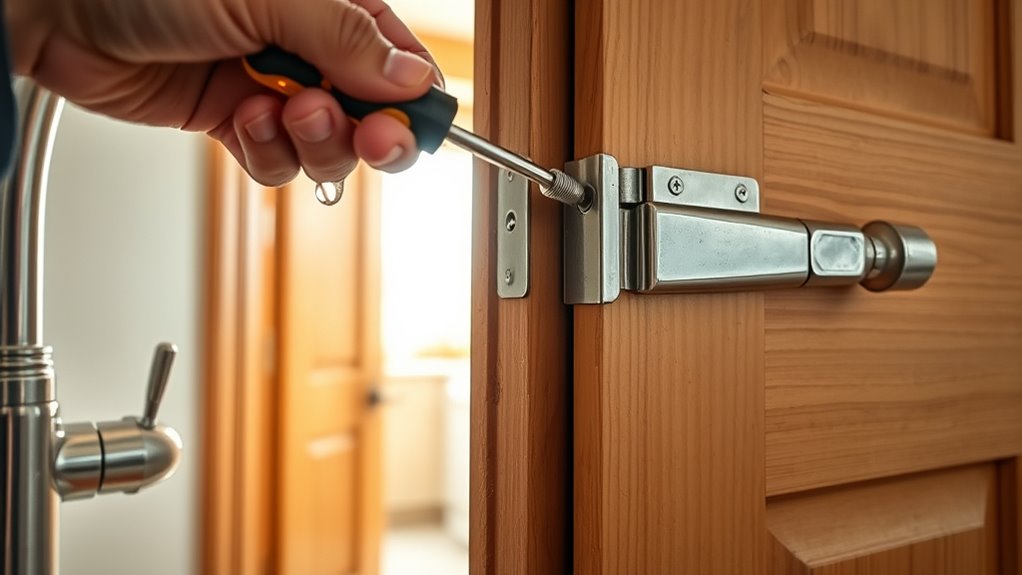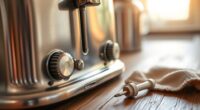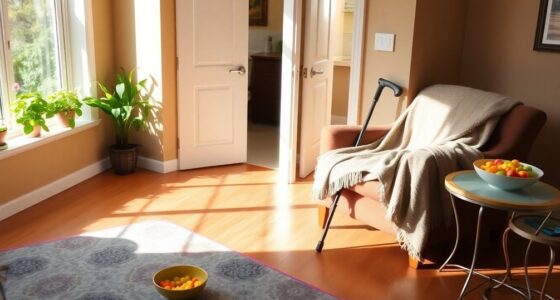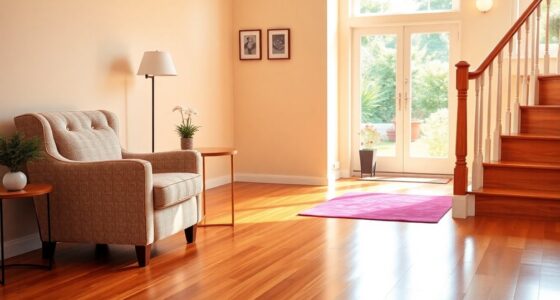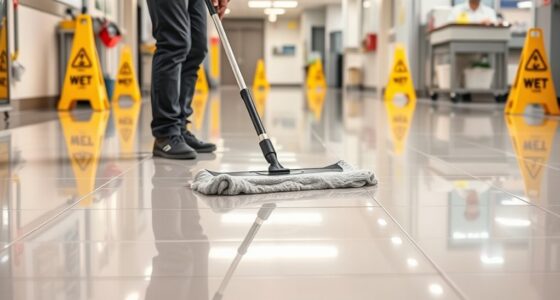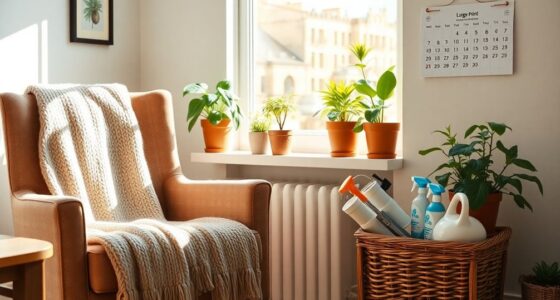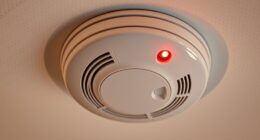To fix squeaky floors, sprinkle talcum powder or graphite into cracks, then tighten loose nails or screws. For drippy faucets, turn off the water, replace worn washers or O-rings, and tighten the packing nut. To stop sticky doors, sand the edges, lubricate hinges with WD-40, and adjust hinges if needed. These simple steps can save you time and money—keep going to discover more helpful tips and tricks.
Key Takeaways
- Lubricate squeaky floors and stairs with talcum powder, soap, or wax, and tighten loose nails or screws.
- Fix dripping faucets by turning off water, replacing worn washers, O-rings, or cartridges, and cleaning the valve seat.
- Address sticky doors by sanding edges, tightening or replacing hinge screws, and lubricating hinges with WD-40 or silicone spray.
- Regularly maintain floors and fixtures to prevent squeaks and leaks from worsening over time.
- Adjust hinges slightly and keep hinges and door edges clean to ensure smooth, squeak-free, and non-sticky door operation.
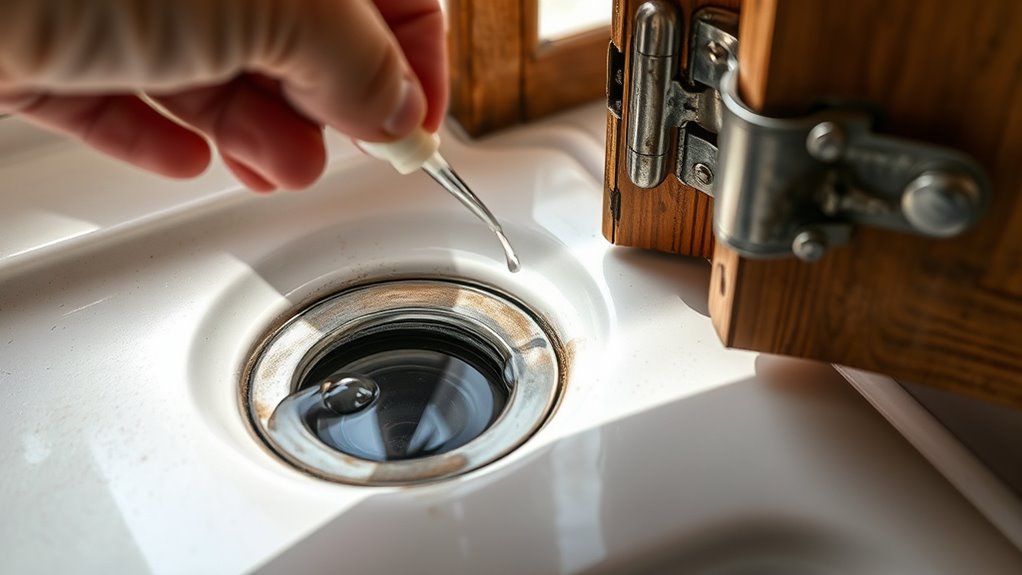
If your home is plagued by squeaks, drips, or sticky doors, you don’t need to call a professional—many issues are simple fixes you can do yourself. Squeaky floors and stairs are often caused by loose boards or friction between wood surfaces. To fix this, grab some talcum powder or powdered graphite and sprinkle it into the cracks or joints. Rubbing a bar of soap or wax into the seams can also reduce squeaking by lubricating the surfaces. If you prefer a more permanent solution, tighten loose nails or screws with a hammer or screwdriver. For stubborn squeaks, you might need to drill small pilot holes and insert finishing nails or use wood glue to secure loose boards. Regular maintenance keeps floors quiet and prevents the problem from worsening. Additionally, applying proper lubrication to moving parts can extend the lifespan of your fixtures and prevent future squeaks.
Leaking faucets are another common annoyance that often has a straightforward fix. Start by turning off the water supply to prevent a flood. Remove the handle using an Allen wrench or screwdriver, then inspect the cartridge, O-rings, or washers, which are usually the culprits. If you see damage or wear, replace these parts with new ones, which are inexpensive and available at hardware stores. Reassemble everything carefully, making sure all components fit snugly. If the leak persists, check the valve seat for corrosion or debris, and clean or replace it if necessary. Sometimes, tightening the packing nut behind the handle can stop minor drips. Regularly replacing worn washers and O-rings can save you money and prevent future leaks altogether.
Sticky doors are a common frustration, especially in humid weather or when humidity levels fluctuate. The first step is to identify what’s causing the stickiness—usually swollen wood, misaligned hinges, or dirt buildup. If the door sticks at the edges, sanding down the area with fine-grit sandpaper can free it up. For doors that sag or won’t latch properly, inspect the hinges. Tighten loose screws or replace missing ones, and lubricate the hinges with WD-40 or a similar lubricant. Sometimes, hinges need to be adjusted slightly to align perfectly with the frame. Clean the hinges and threshold to remove dirt or debris that may cause sticking. Applying a thin coat of petroleum jelly or silicone spray can help the door glide smoothly. By addressing these issues promptly, you’ll keep your doors functioning properly without expensive repairs or replacements. Keeping up with regular maintenance prevents these problems from becoming more serious, saving you time and money in the long run.
Frequently Asked Questions
How Often Should I Perform Maintenance to Prevent Squeaks and Drips?
You should perform maintenance every six months to prevent squeaks and drips. Regularly check hinges, door latches, and plumbing fixtures for signs of wear or leaks. Lubricate door hinges and moving parts as needed, and tighten any loose fittings. Keeping up with these tasks helps catch small issues early, saving you time and money in the long run. Consistency is key to maintaining smooth, noise-free doors and leak-free fixtures.
Are There Eco-Friendly Products for Fixing Squeaks and Leaks?
Yes, you can find eco-friendly products to fix squeaks and leaks. Look for biodegradable lubricants made from natural oils that reduce friction without harmful chemicals. For leaks, choose plant-based sealants or biodegradable caulks that are safe for the environment and your home. These options work effectively and help you maintain your space sustainably. So, next time, opt for green solutions and keep your repairs eco-conscious.
Can DIY Fixes Damage My Door or Plumbing?
DIY fixes can potentially damage your door or plumbing if you’re not careful. Using the wrong lubricant, over-tightening screws, or applying too much force can cause cracks or leaks. To avoid this, follow instructions carefully, use appropriate tools, and opt for eco-friendly products designed for your specific issue. When in doubt, consult a professional to prevent costly damage and make sure your repairs are safe and effective.
What’s the Best Time of Day to Fix Squeaks or Leaks?
Think of fixing squeaks or leaks as catching a butterfly—best done when it’s calm and quiet. The ideal time is early morning or late evening when household activity slows down. During these times, you’ll have better access and less disturbance, making repairs smoother. Plus, you’ll avoid rushing, which reduces mistakes. So, pick a quiet moment, and you’ll find fixing these issues easier and more effective.
When Should I Call a Professional Instead of DIY?
You should call a professional if you’re unsure about diagnosing the problem or if DIY fixes don’t resolve the issue. If the squeak, drip, or sticky door persists after your efforts, or if you notice underlying damage, it’s best to get expert help. Avoid risking further damage or injury by attempting complex repairs beyond your skill level. Professionals can guarantee proper, safe, and lasting fixes.
Conclusion
Now that you’ve got these simple fixes up your sleeve, squeaks, drips, and sticky doors won’t be your household’s chorus anymore. Think of your home as a well-tuned instrument—you’re the conductor, ready to silence the unwanted noise. With just a few tweaks, you’ll turn chaos into harmony, creating a peaceful space where everything runs smoothly. So roll up your sleeves and get to it—your home’s silent symphony awaits!
